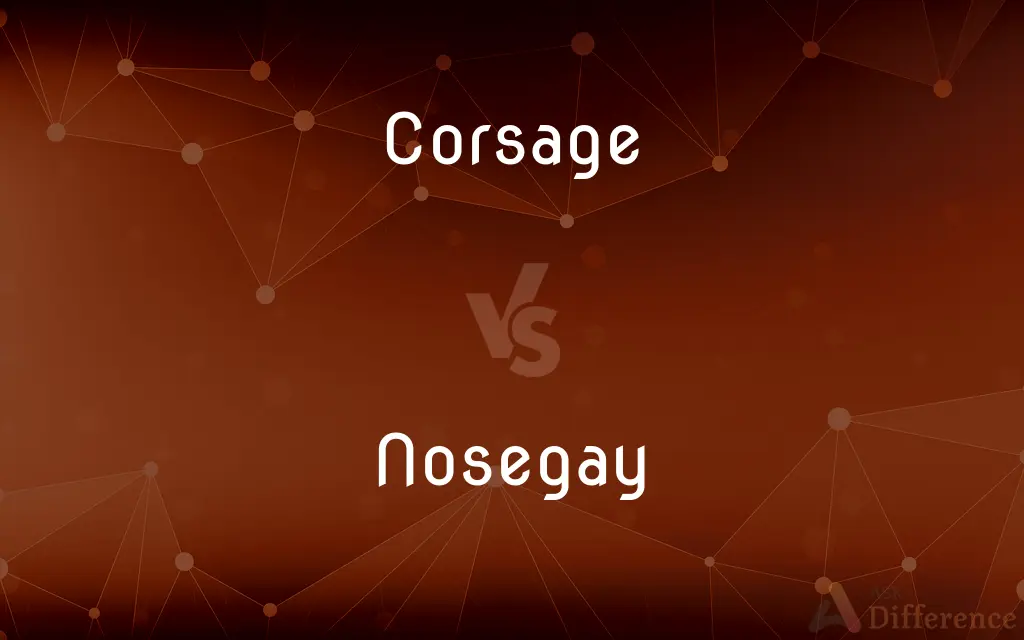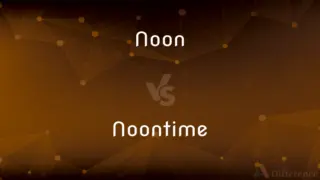Corsage vs. Nosegay — What's the Difference?
By Maham Liaqat & Urooj Arif — Updated on March 28, 2024
A corsage is a small bouquet worn on a woman's dress or wrist for formal occasions, while a nosegay is a compact, round bouquet of flowers held in the hand, often used in weddings.

Difference Between Corsage and Nosegay
Table of Contents
ADVERTISEMENT
Key Differences
Corsages are decorative flower arrangements, typically consisting of a few flowers with foliage, designed to be worn on clothing or around the wrist. They are a traditional accessory for formal events like proms, weddings, and dances, symbolizing special occasions or honors. On the other hand, nosegays are small, handheld bouquets with a mix of flowers and herbs, tightly bound and often used by brides and bridesmaids in weddings. The term "nosegay" historically referred to a bouquet meant to appeal to the nose or offer a pleasant scent.
While corsages are worn as personal adornments and often pinned to a garment or tied around the wrist, nosegays serve as a decorative element that complements wedding attire and decor. Nosegays can also be used as a decorative item in homes or at events, placed in vases or as table centerpieces.
The selection of flowers in a corsage is typically guided by the wearer’s attire, personal preference, and the symbolism of the flowers, with an emphasis on complementing a specific outfit or occasion. In contrast, nosegays often follow a wedding’s color scheme or theme, incorporating flowers that match or enhance the overall decor and ambiance.
Corsages and nosegays both play significant roles in celebrations and ceremonies, but their purposes and ways of incorporation into the events differ. Corsages highlight individual significance on special occasions, while nosegays are more about contributing to the visual and thematic cohesion of a wedding or similar event.
Despite their different uses, both corsages and nosegays share the commonality of utilizing flowers to convey messages, emotions, and aesthetic appeal. The choice between them depends on the nature of the occasion, the role of the person in the event, and personal preference in floral accessories.
ADVERTISEMENT
Comparison Chart
Purpose
Worn as a decorative accessory on clothing or around the wrist
Held in the hand as part of wedding attire or used as decor
Occasion
Formal events like proms, weddings, dances
Primarily weddings, but also suitable for home or event decor
Placement
Pinned to clothing or tied around the wrist
Held in the hand or placed as a decorative item
Composition
Few flowers with foliage, emphasizing personal adornment
Compact, round bouquet of flowers and herbs
Symbolism
Signifies special occasions or honors
Complements wedding themes and appeals to the senses
Customization
Matched to attire and personal preference
Coordinated with wedding colors and decor
Role
Highlights individual significance
Enhances visual and thematic cohesion of events
Compare with Definitions
Corsage
Symbol of honor or celebration.
The corsages were reserved for the honorees at the ceremony.
Nosegay
Used in weddings.
Each bridesmaid held a nosegay that matched the wedding's color scheme.
Corsage
Matches attire or theme.
The bridesmaids' corsages complemented their dresses perfectly.
Nosegay
Offers pleasant scent.
The nosegay included herbs and lavender for a soothing aroma.
Corsage
A small floral accessory for formal wear.
She chose a rose corsage to match her prom dress.
Nosegay
Decorative element.
Nosegays adorned the tables as part of the wedding decor.
Corsage
Worn on special occasions.
The mother of the bride wore a lavender corsage.
Nosegay
A compact handheld bouquet.
The bride carried a nosegay of wildflowers down the aisle.
Corsage
Personal adornment.
Her wrist corsage featured her favorite flowers, peonies.
Nosegay
Thematic cohesion.
The nosegays were designed to echo the rustic theme of the ceremony.
Corsage
A corsage is a small bouquet of flowers worn on clothing or around the wrist for formal occasions, commonly by females in the United States. They are typically presented to a female by their date.
Nosegay
A nosegay, posy, or tussie-mussie is a small flower bouquet, typically given as a gift. They have existed in some form since at least medieval times, when they were carried or worn around the head or bodice.
Corsage
A small bouquet of flowers worn at the shoulder or waist or on the wrist.
Nosegay
A small bunch of flowers; a bouquet.
Corsage
The bodice or waist of a dress.
Nosegay
A small bunch of fragrant flowers or herbs tied in a bundle, often presented as a gift; nosegays were originally intended to be put to the nose for the pleasant sensation or to mask unpleasant odours.
Corsage
(obsolete) The size or shape of a person's body.
Nosegay
(figuratively) An aroma, a scent.
Corsage
The waist or bodice of a woman's dress.
Nosegay
A bunch of odorous and showy flowers; a bouquet; a posy.
Corsage
A small bouquet of flowers, originally worn attached to the bodice of a woman's dress.
Nosegay
An arrangement of flowers that is usually given as a present
Corsage
The waist or bodice of a lady's dress; as, a low corsage.
Corsage
A flower or small arrangement of flowers worn by a person as a personal ornament. Typically worn by women on special occasions (as, at a ball or an anniversary celebration), a corsage may be worn pinned to the chest, or tied to the wrist. It is usually larger or more elaborate than a boutonniere.
Corsage
An arrangement of flowers that is usually given as a present
Common Curiosities
What occasions are corsages worn for?
Corsages are worn for formal events such as proms, weddings, dances, and ceremonies to signify special occasions or honors.
How do you choose flowers for a corsage or nosegay?
The choice of flowers can be based on personal preference, the symbolism of the flowers, and how well they complement attire or decor.
How do you wear a corsage?
A corsage can be pinned to the clothing, typically on the left side, or worn around the wrist with a ribbon or bracelet.
What is the significance of a nosegay at a wedding?
Nosegays add aesthetic appeal, complement the wedding theme, and can carry symbolic meanings through the choice of flowers and herbs.
Can men wear corsages?
Men typically wear boutonnieres, which are small flower arrangements pinned to the lapel, rather than corsages.
Can nosegays be used for purposes other than weddings?
Yes, nosegays can also serve as decorative elements in homes or at various events, providing visual appeal and fragrance.
How are corsages and nosegays tailored to individual styles?
Through the selection of specific flowers, colors, and arrangements that reflect personal tastes or match event themes.
Are corsages and nosegays expensive?
The cost can vary widely depending on the type of flowers used, the complexity of the arrangement, and the florist's pricing.
How long do corsages and nosegays last?
With proper care, they can last several days, but they are generally intended as temporary adornments for specific events.
What cultural significance do corsages and nosegays hold?
Both have historical and cultural significance, often symbolizing love, honor, and celebration in various contexts.
How do corsages and nosegays differ in design?
Corsages are designed to be worn and often feature fewer flowers, while nosegays are handheld bouquets that are compact and rounded.
Is it appropriate to give a corsage or nosegay as a gift?
Yes, both can be thoughtful and appropriate gifts, especially for special occasions or as part of wedding tradition.
What herbs are commonly used in nosegays?
Herbs like lavender, rosemary, and mint are popular for their pleasant scents and symbolic meanings.
Can you make your own corsage or nosegay?
Yes, with some floral supplies and a bit of creativity, it's possible to DIY both corsages and nosegays.
Do corsages and nosegays need special care?
To prolong their freshness, keep them cool and moist until they are worn or displayed.
Share Your Discovery

Previous Comparison
Noon vs. Noontime
Next Comparison
Burgundy vs. MagentaAuthor Spotlight
Written by
Maham LiaqatCo-written by
Urooj ArifUrooj is a skilled content writer at Ask Difference, known for her exceptional ability to simplify complex topics into engaging and informative content. With a passion for research and a flair for clear, concise writing, she consistently delivers articles that resonate with our diverse audience.
















































